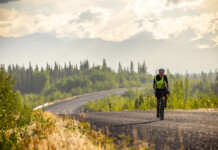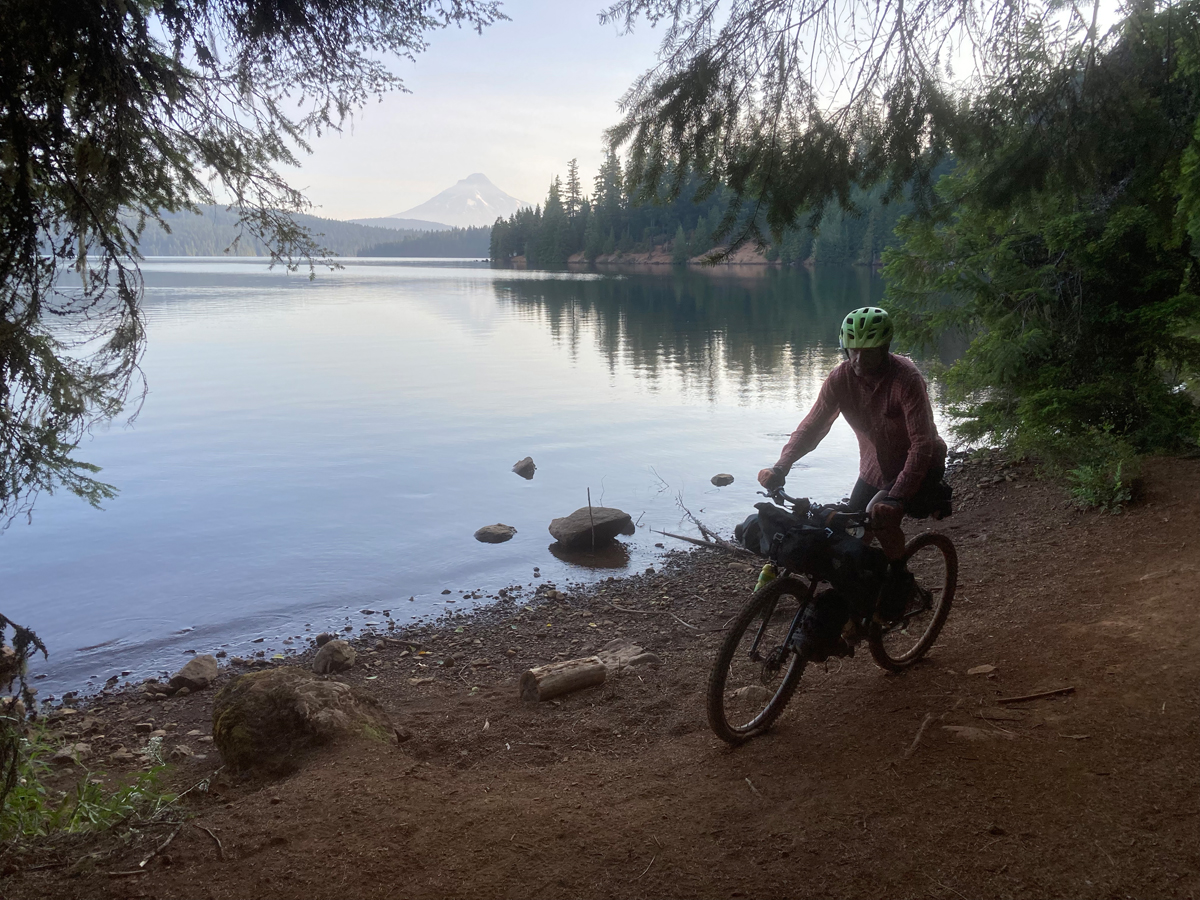By Jill Homer — It was one of the most life-affirming moments I’ve experienced. I stood on a sandstone ledge wearing every stitch of clothing I’d packed into bicycle bags for an overnight trip in the desert. Inside my coat, I cradled a hydration bladder with three liters of icy water to keep it from freezing solid. I was exhausted at 7 a.m., both from the long pedal to reach this high overlook, and from shivering through the night. In this bleary state, I watched as the rich light of this late November morning stretched across a desert floor more than a thousand feet below. My heart fluttered in wonder as a bright orange glow crept up the sculpted sandstone monoliths known as the Cathedrals. It’s difficult to describe the elation I felt. I had survived the night. The world was endlessly beautiful. Everything was going to be okay.
Over Thanksgiving 2020, my friend, Danni Coffman, and I met up from our respective quarantine zones — Montana and Colorado — for a week of bikepacking in the Utah desert. We spent a couple of days on the White Rim in Canyonlands National Park before moving onto a more remote region of central Utah for an overnight ride through the Cathedral Valley. We planned this trip as a brief respite from the long isolation of the COVID-19 pandemic. This meant it was a no-frills, self-supported endeavor. We brought all of our food and water, didn’t venture into local businesses, and even maintained a physical distance from each other while riding. These were strange times, but we were glad to simply be out in the world again.
And what a world! Located in Capitol Reef National Park, the Cathedral Valley is known for entrada sandstone monoliths rising from the sand. The cathedrals are so named because they resemble ornate structures built to withstand the harsh winds that scrape the desert floor. The first superintendent of Capitol Reef, Charles Kelly, explored the area in 1945 and decided the Gothic sandstone formations deserved a grand name.
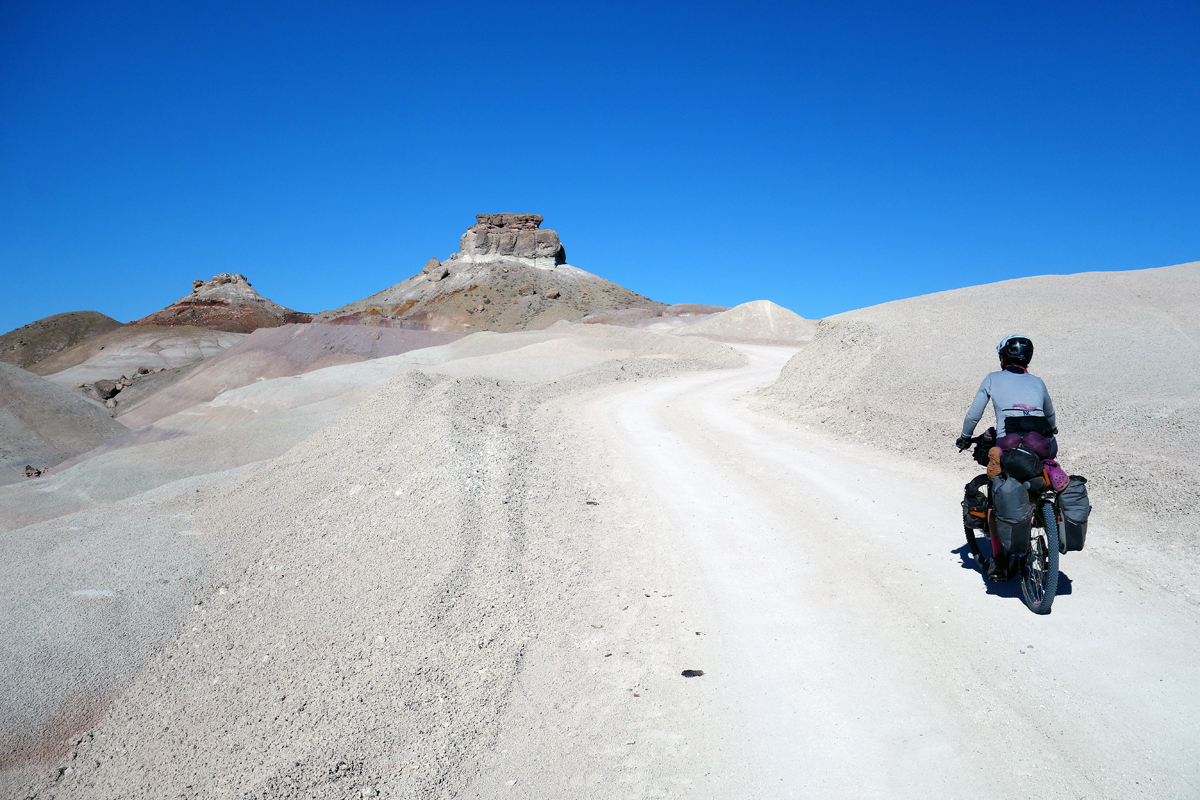
Other unique features in the region include the Bentonite Hills. These barren yet colorful, contoured mounds formed during the Jurassic period when mud, fine sand, and volcanic ash were deposited in swamps and lakes. This beautiful moonscape can be the bane of both drivers and cyclists when it rains because bentonite clay becomes extremely sticky when saturated. Even foot travel becomes impossible as the gray sludge builds up in thick layers on any surface it touches.
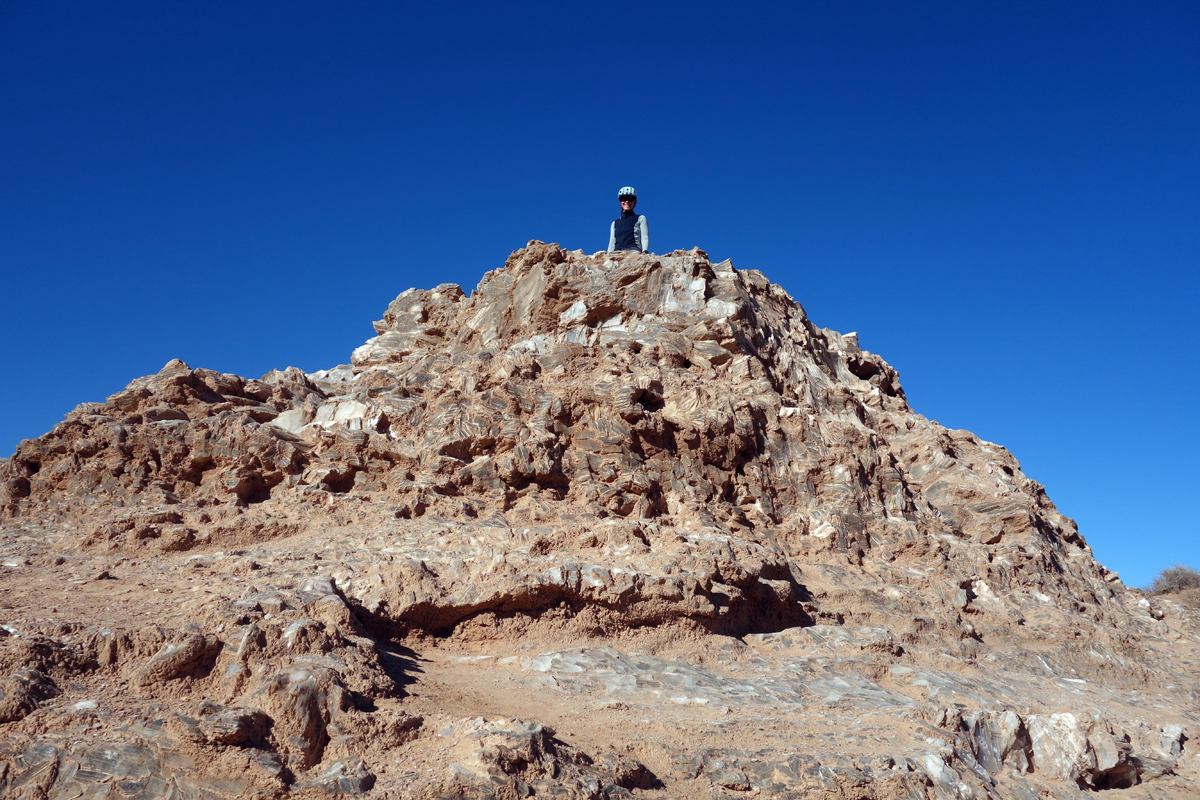
Then there’s Glass Mountain, a house-sized mound of exposed selenite crystals. This sparkly “mountain” formed when gypsum carried by groundwater began to crystalize, causing a “plug” that is now eroding away.
The Gypsum Sinkhole formed from the reverse of this process, as groundwater dissolved buried gypsum, collapsing the surrounding rock layers, and leaving a sinkhole that is nearly 200 feet deep. These geologic anomalies add to the otherworldly atmosphere of Cathedral Valley.
Most visitors explore the area via a 58-mile loop on rugged, sandy roads. A popular bikepacking Web site, bikepacking.com, took this scenic drive and added a few side trips for an ideal bikepacking overnight: 76 miles, 4,607 feet of climbing, and 92 percent unpaved. Near the halfway point is an established campground where visitors can stay for free on a first-come, first-served basis. There is typically no water on the route, so bikepackers will need to carry at least two days’ worth. This can range from five or six liters in the winter months, to as many as 12 in the heat of the summer. The rugged terrain and limited resources make the Cathedral Valley loop a tough but worthy challenge.
Danni and I set out around noon on November 27, 2020. We had to drive from Moab that morning, which led to this late start, but we were confident we could reach the campground at mile 35 before dark. First, we had to contend with a crossing of the Fremont River. We opted to start our ride at the junction of Hartnet Road and Highway 24, then ride clockwise. We figured it would be best to ford the river in the relative heat of midday and hoped the dry autumn months would mean lower flows on this major tributary. What we found was an ice-choked shoreline and swift-flowing water the color of chocolate milk. We removed shoes and socks and shouldered our gear-laden mountain bikes. Danni got a head start and picked the best line, walking diagonally to the bank until she reached the other side of the road about 50 yards upstream. I tried a direct crossing and ended up fighting the swift current in a thigh-deep channel. I could not find a ramp to climb up the near-vertical bluff and nearly dropped my bike as my feet went numb. It was harrowing, but the hard part was now over … right?
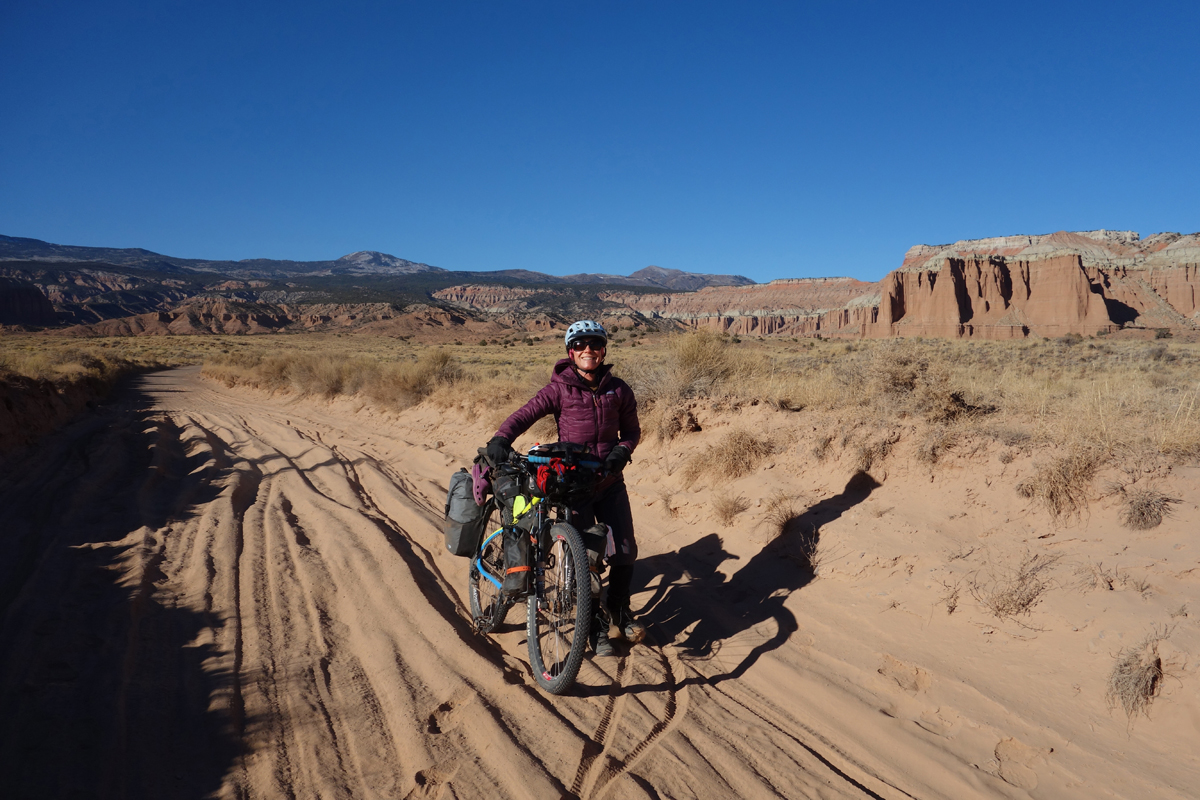
The ride along the washboard gravel of Hartnet Road was difficult but decidedly more pleasant. We climbed through the Bentonite Hills and enjoyed the sweeping vistas of North Blue Flats. A diversion to the South Desert Overlook revealed jaw-dropping views of Jailhouse Rock, which rises 500 feet from the valley floor. I dragged Danni through all of the recommended side trips and lingered so long that our daylight ended up running short. We watched the sun set over the Upper Cathedral Valley and pulled into camp with the last light of dusk.
Temperatures plummeted with the disappearance of the sun. We bundled up in puffy jackets and pants, fired up stoves to rehydrate meals, and crawled into our tents before 7 p.m. Here I would discover that while the Utah desert is an ideal location for a late-November bikepacking trip, it’s also far from balmy at 7,200 feet. My lightweight sleeping bag, rated to 32 degrees, was not going to cut it. On this night, the temperature plunged to a chilling 4 degrees (F.) I moved both my fuel canister and drinking water bladder into my sleeping bag to prevent freezing. I’m no stranger to winter camping, but without the proper gear, it’s a miserable experience indeed. Throughout the night, I alternated between shivering until I lapsed into sleep, snoozing for thirty minutes or so, waking up from unconscious shivering, and leaving my tent to pace the campground until my limbs felt somewhat warm again. Then I repeated the process. It was one of the longest nights of my life.
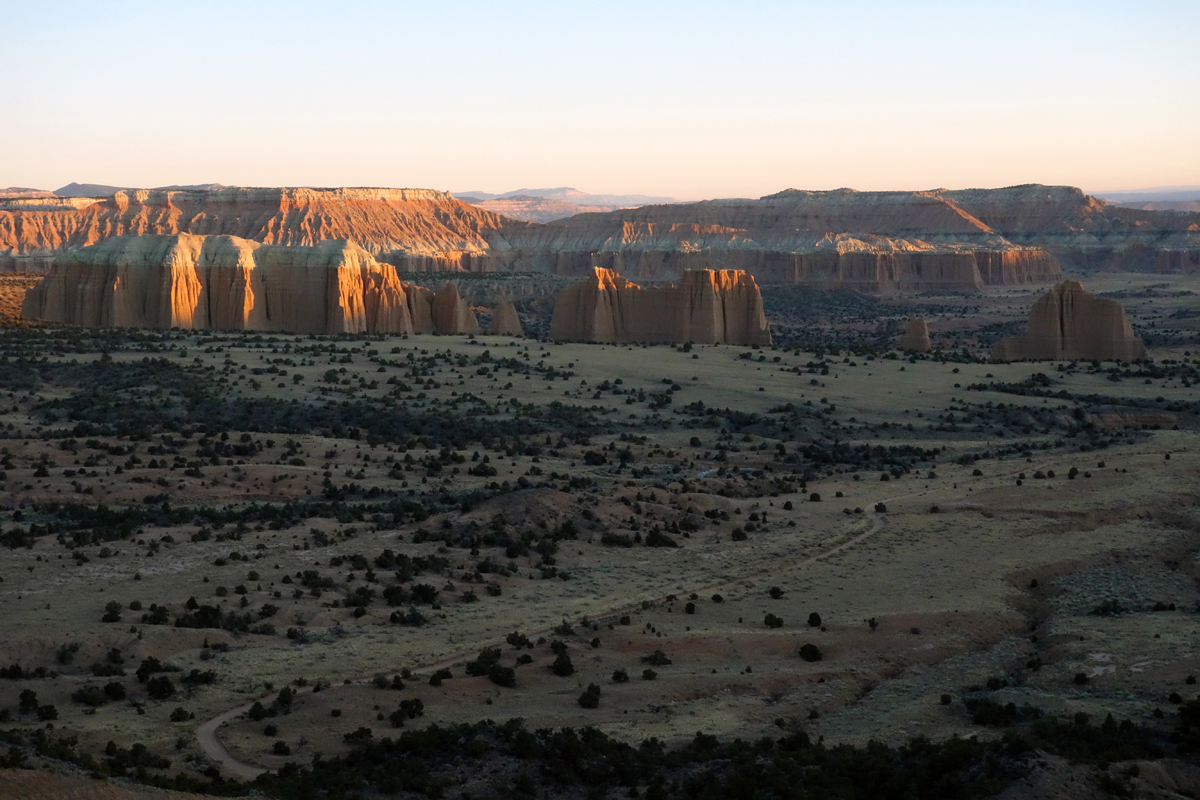
At 6:30 a.m., the first hints of dawn started to appear on the horizon. I decided to finally get up for good. My muscles were so stiff from shivering that I walked like a zombie for several steps, cradling my water bladder — I called it my “ice baby” — beneath my puffy coat. The air still felt painfully cold, but a streak of crimson light appearing over the juniper-clad foothills gave me hope. I waddled to an overlook at the edge of the campground and gasped when I gained my first full view of the Upper Cathedral Valley. Watching the rising sun cast its glimmer of warmth on the cathedrals was an incredible experience. It was almost worth suffering through the long, cold night … almost.
Danni had a better sleeping bag and fared much better than me through our 12 hours of waiting out the long night. I was eager to start moving again, but she was content to linger over coffee and oatmeal as the morning sun rose high enough to spread real warmth across the desert sand.
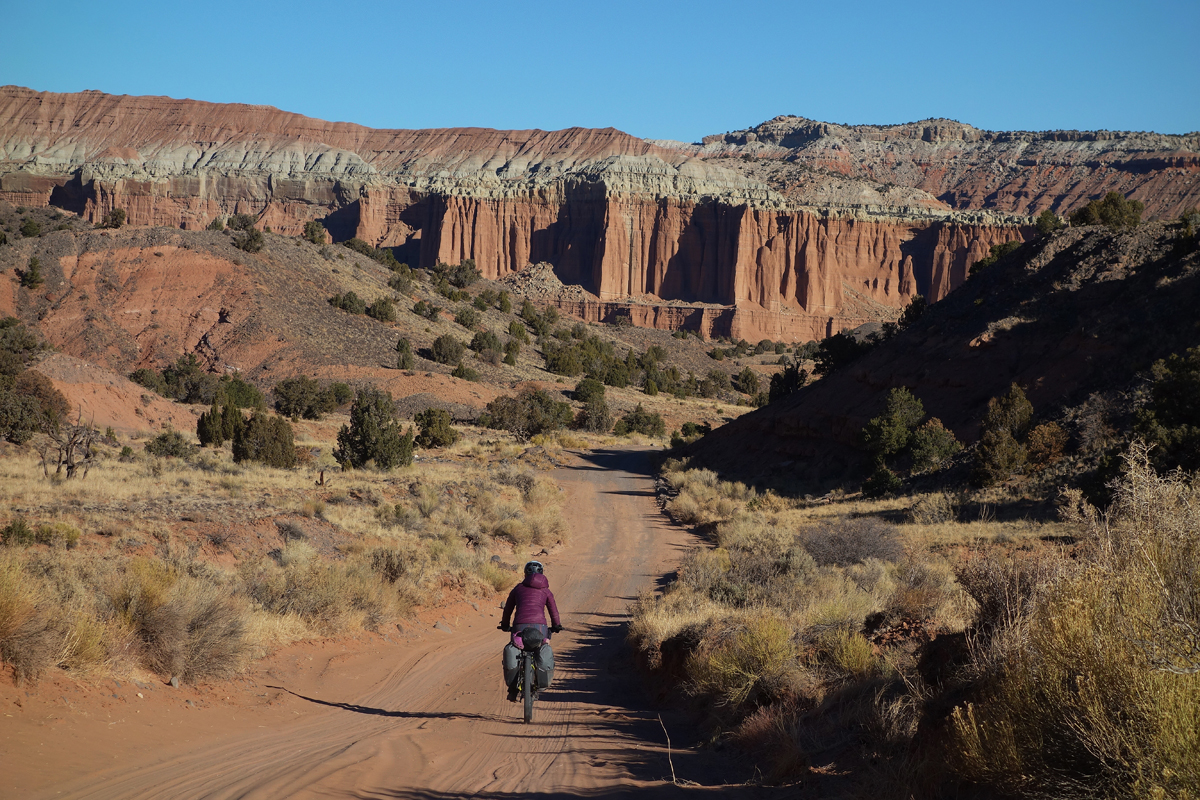
Finally, we launched into the long descent into the valley, craning our necks at the cathedrals as we pedaled and swerved through a veritable sandbox. At higher altitudes, the road had been rocky, but the surface dissolved into increasingly deep sand that proved challenging when it came to maintaining momentum. We’d launch into sandpits and pedal with all of our might, only to swerve and stall and finally put a foot down.
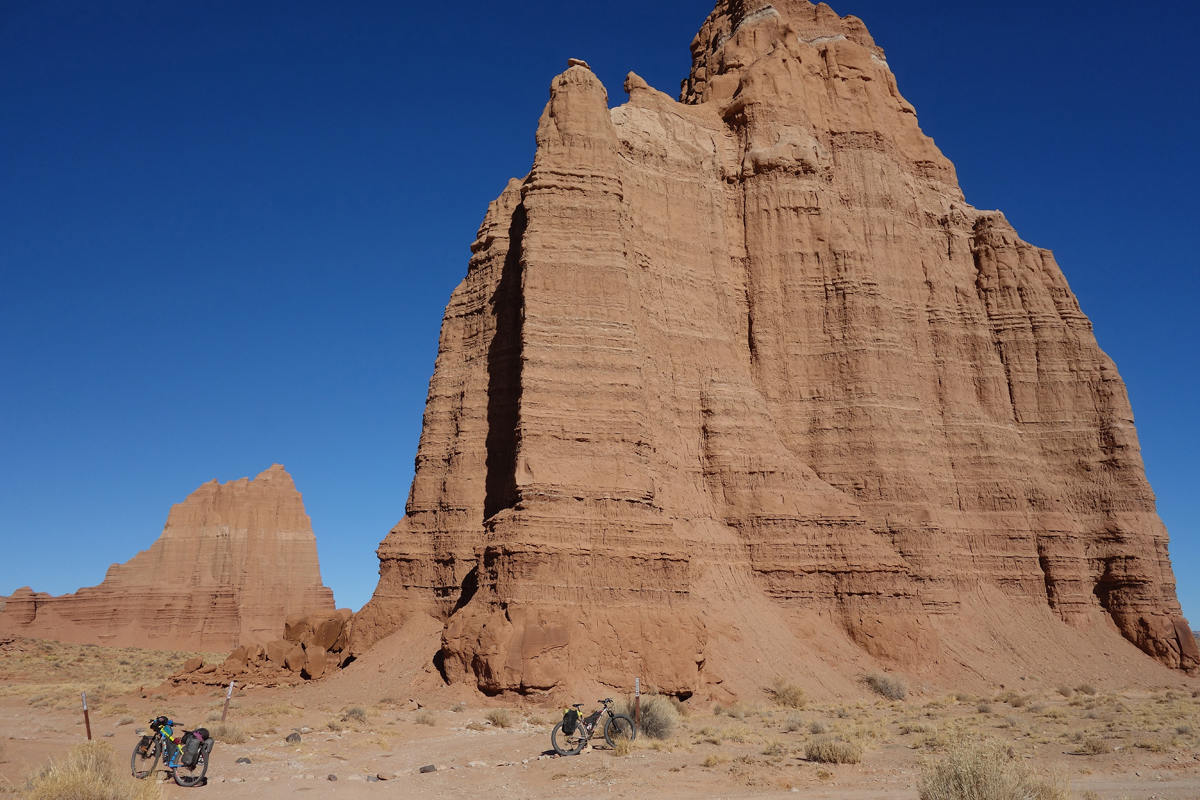
Again, I dragged Danni through all of the side trips. She was beginning to feel the fatigue of long days of pedaling but was a good sport about my insistence that we had to visit the Gypsum Sinkhole, Glass Mountain, and Temples of the Moon and Sun. Although we were generally descending — a reward for the continuous climbing of the first day — the deep sand kept us churning. Meanwhile, sheer sandstone cliffs and cathedrals loomed overhead. Late-autumn shadows cast a stark contrast of deep reds against shimmering yellow and orange hues. In this light, the formations seemed particularly stoic and grand.
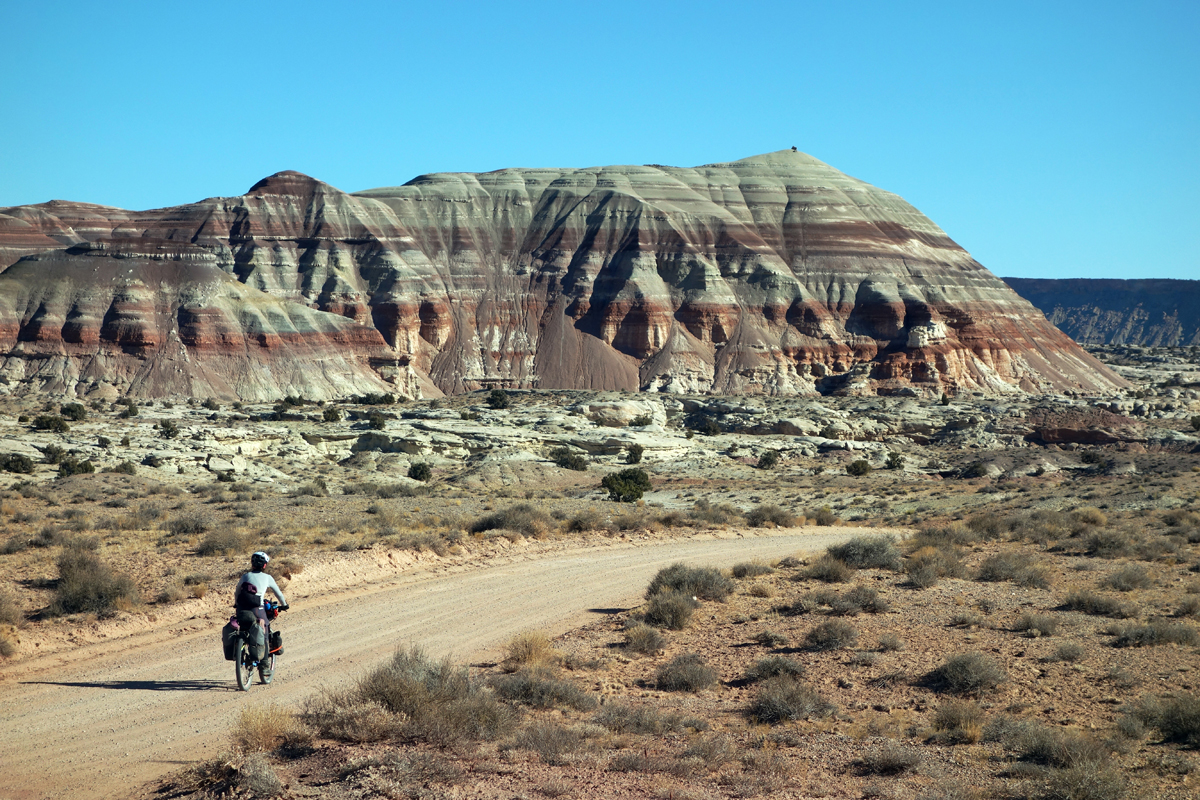
We descended out of the national park and into the rolling and colorful hills and arroyos of the Painted Desert. On this section, I relished in launching into a descent and full speed and staying in the big ring as I mashed the pedals up another punchy climb. The afternoon sun felt almost hot. Danni and I had finally shed most of our layers by the time we arrived back at Highway 24 for a six-mile pavement pedal to our cars. It had been a brief journey — just over 24 hours — and we’d pedaled a mere 76 miles in that time. But it felt like we’d traveled to the far end of the world and back.
More information and a GPS track can be found at: https://bikepacking.com/routes/cathedral-valley-loop.
Facts (from bikepacking.com):
- Distance: 76 miles
- Days: 2
- Unpaved: 92%
- Difficulty: 5 out of 10
- Rideable: 100%
- Total ascent: 4,607 feet
- High point (Cathedral Campground): 7,204 feet
Notes: There is no water on route. Within the national park, camping is only permitted in the campground. Be prepared to be self-sufficient, and if it’s early or late in the season, it is more than worth carrying a few extra layers and a warmer sleeping than you think you’ll need.
The best seasons for the Cathedral Valley Loop are spring and autumn. It can be ridden any time of year, but winter and summer rides will require extra gear or water. Temperatures can dip below zero during the winter months and climb above 100 degrees in the summer. There is limited shade, no resupply, and no shelter along the route.


